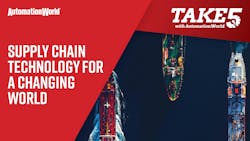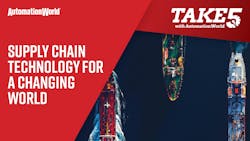
Quick hits:
- COVID-19 revealed underlying structural weaknesses in the global supply chain.
- Automated data collection and management can enable visibility into the movement of goods and materials that was previously impossible.
- The value of that data can be tapped to unlock powerful predictive capabilities, allowing companies to stay ahead of the curve.
Related to this episode:
- The pandemic is shaping the future supply chain
- How intelligence is powering supply chain's next wave
- Simulating supply chains to conquer complexity
- Gain an in-depth look at PMMI's research on automation and hear from experts on industry topics by visiting PMMI's Business Intelligence video library.
Hello and welcome to Take Five with Automation World. I'm David Miller, Senior Technical Writer for Automation World.
Today, I'd like to talk about something that's making major headlines and not just in our industry—supply chains. So, we all know that there have been major disruptions to supply chains in the past year or so and it's commonly perceived that this was set off by some of the port closures, labor shortages, and the lockdowns related to COVID-19. And that was certainly the catalyst, but the problem had actually been gestating since before COVID-19. COVID-19 just revealed it.
What supply chains have is an issue where the production of goods is very distant and segmented, with components for an end-product made in dozens of different countries, sometimes meaning that the loss of access to just one can prevent a finished good from being produced entirely. We also have more shipping crates coming into the US than going out, meaning that in the countries that ship to us, their prices are increasing, and then we have driver shortages State-side that cause bottlenecks once goods are taken off the boat, and hit the road en-route to their final destination.
So, obviously there are what we might term some structural issues at play here, but for our purposes here at Automation World, I'd like to point out some of the technologies that are becoming more prevalent in order to help companies navigate this very rapidly changing and uncertain landscape. So, in this regard, much of what we're seeing is in line with common Industry 4.0 trends. First of all, there's been a rise in the automation of data collection and management. So, just like with something such as predictive maintenance, data, that was once gathered quite literally just by being written down on a clipboard by someone who was pacing up and down the aisles of a factory or a warehouse, some kind of facility like that, is now being collected automatically via intelligent sensors and consolidated digitally after being sent over a network. So, even more important than what we see is centralized cloud storage being used for this.
The consolidation happens not just within a single facility, but across many locations. And that kind of enhanced visibility essentially enables better planning. And as with much of Industry 4.0, what can be achieved in terms of optimization, really comes down to what people are doing with that data and visibility. This data and our access to it, opens up a world of possibilities. Most obviously, simply having more visibility enables better planning. People know what goods we have and where they all are at all times. They're constantly being tracked, but perhaps what's more interesting is that when we pair this supply or inventory data with external demand data, we start to get a picture, not just of how much we have, or can have at any given point in time, but how much we need or will need in the future.
For instance, I heard a story from a company that produces building materials about how they were using information from banks, that pertained to the issuance of home mortgage loans to predict how much of their product they would need to supply in order to meet the demand for new construction starts forecasting significantly into the future. That's just one of hundreds of examples we could give. In essence, what we're looking at is a world where companies have shrinking profit margins and that mandates they run their businesses more efficiently. And typically in the past, just in time models would have been employed, that limit cost that are related to stocking inventory. But now with supply chains becoming less reliable, we see that beginning to cause more harm than good. And it's just becoming untenable. What this means is that you can't know you'll have the product you need when you need it.
And what these technologies are allowing companies to do is match supply to demand as best as possible. Basically, to get as close to that just in time model, as they can, while also minimizing the risk that comes with operating in an uncertain environment. It's really that simple. It's kind of like having your cake and eating it too, you might say.
So, there's much, much more to this topic, but in this short five-minute video, that's all I can talk about today. Keep your eyes on Automation World homepage for more news relating to supply chain technology to come in the days ahead.
